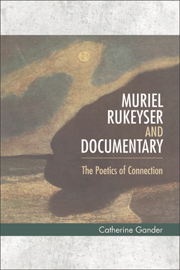6 - Conclusion
Published online by Cambridge University Press: 05 August 2013
Summary
Rukeyser begins The Life of Poetry with a call to arms and an affirmation: ‘In time of crisis, we summon up our strength.’ This ‘strength’, she asserts, may be derived from ‘every forgotten image … every memory that can make us know our power’. For Rukeyser, in a manner similar to that discovered by Francis Galton when conducting his experiments into language and mental imagery, the singular image of a boat generates and communicates a vast network of imaginative associations. Summoning the memory of her evacuation from Spain, Rukeyser writes simply, ‘I think now of a boat on which I sailed away from the beginning of a war.’ The mental images triggered and retrieved in the introduction to The Life of Poetry provide the material and the motive for the book; their multiplicity and connectedness underline what Rukeyser understood throughout her life to be the guiding principles of poetry. Having arrived in Spain as an investigative journalist, Rukeyser recalls that she left the country determined to communicate what she had seen and felt, her resolve strengthened by a question posed by a fellow refugee: ‘“where is there a place for poetry?”’
- Type
- Chapter
- Information
- Muriel Rukeyser and DocumentaryThe Poetics of Connection, pp. 208 - 214Publisher: Edinburgh University PressPrint publication year: 2013

